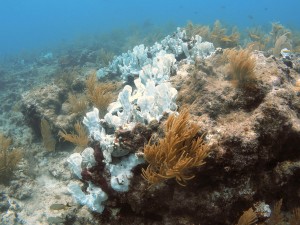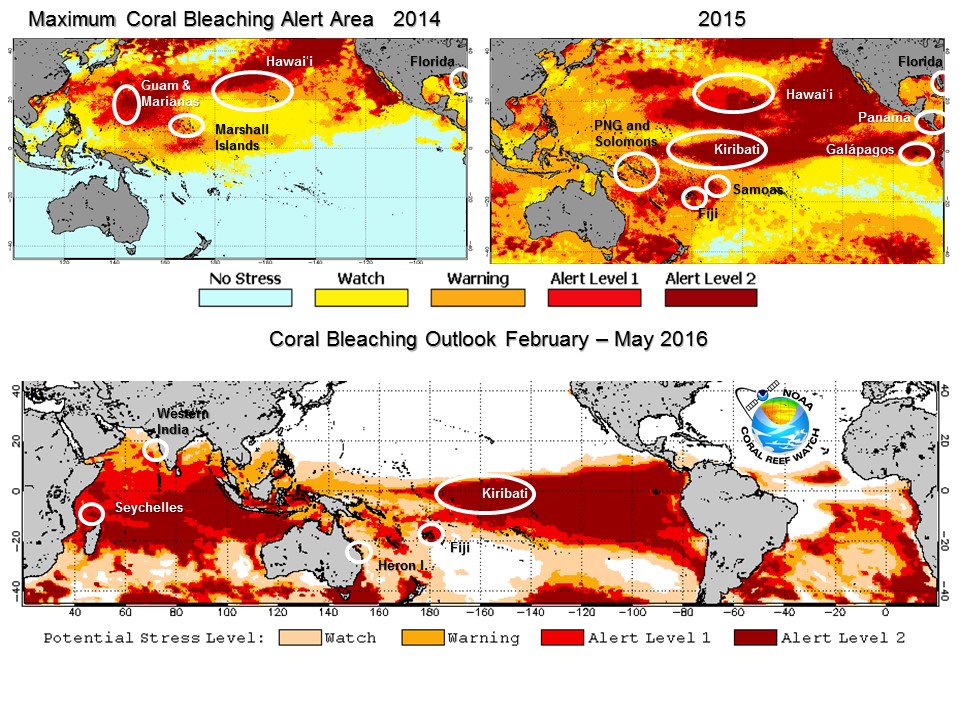23 February 2016
NEW ORLEANS – Global warming and the intense El Niño now underway are prolonging the longest global coral die-off on record, according to NOAA scientists monitoring and forecasting the loss of corals from disease and heat stress due to record ocean temperatures. The global coral bleaching event that started in 2014 could extend well into 2017, researchers report at the Oceans Sciences Meeting here this week.

Coral bleaching happens when corals are stressed by conditions such as high temperatures. According to new research, global warming and the intense El Niño now underway are prolonging the longest global coral die-off on record.
Credit: USGS.
Coral bleaching happens when corals are stressed by conditions such as high temperatures. The bleaching, or whitening, occurs when the corals expel the symbiotic algae that live in their tissues. Without the algae, corals lose a significant source of food and are more vulnerable to disease. In a severe bleaching event, large swaths of reef-building corals die. This causes reefs to erode, destroying fish habitat and exposing previously protected shorelines to the destructive force of ocean waves.
Warmer ocean temperatures caused by El Niños and global warming can lead to coral bleaching. The first mass bleaching occurred during the 1982-83 El Niño. A global bleaching event was then confirmed in 1998 during a strong El Niño that was followed by a very strong La Niña, which brings warmer waters to places like Palau and Micronesia. A second global bleaching event occurred in 2010, during a less powerful El Niño.
Scientists first observed the current global coral bleaching event beginning in mid-2014 when bleaching began in the western Pacific Ocean. In October 2015, as the current El Niño was still strengthening, NOAA scientists declared the third global bleaching event on record was underway.
New research finds that this bleaching event has persisted for 20 months and could reach into 2017, said Mark Eakin, a biological oceanographer at NOAA in College Park, Maryland, and coordinator of NOAA’s Coral Reef Watch.

The top images show the maximum thermal stress levels measured by NOAA satellites in 2014 and 2015 along with locations where the worst coral bleaching was reported. The bottom image shows the Four Month Bleaching Outlook for February-May 2016 based on the NOAA Climate Forecast System model along with locations.
Credit: NOAA.
“This time we’re in the longest coral bleaching event,” Eakin said. “We’re maybe looking at a 2- to 2-1/2-year-long event. Some areas have already seen bleaching two years in a row.” Eakin and his colleagues will be presenting the latest update and outlook for the global bleaching event Friday at the 2016 Ocean Sciences Meeting co-sponsored by the Association for the Sciences of Limnology and Oceanography, The Oceanography Society and the American Geophysical Union.
The length of the event means corals in some parts of the world have no time to recover before they are hit by another bleaching event, Eakin said. The current global bleaching event is hammering some reefs repeatedly. Reefs bleached in 2015 in the Caribbean and Florida Keys, for instance, have just started to recover, but may start bleaching all over again as early as July, according to Eakin. In the Pacific, reports are just coming in that corals in Fiji’s nearshore waters are bleaching with lots of dead coral.
“This is now two years in a row for Fiji and it’s looking like 2016 may be worse than 2015,” Eakin said.
The rate of return of bleaching events has been faster than some reefs can recover, he noted. In 1998 in Southeast Asia, for example, there was a severe bleaching event, followed by twelve years of recovery that allowed some of the more rapid-growing, branching corals to grow back. However, the slower-growing corals that build the backbone of reefs did not recover. In 2010, the same area was hit again by a global bleaching event, killing off newly-grown branching corals and many of the surviving massive corals. These reefs may see bleaching again later this year, Eakin said.
“That was only six years ago,” he said. “We’re seeing global bleaching again now. The frequency of mass bleaching events are going up because of global warming. We are hitting the corals, then we are hitting them again, and then again.”
Notes for Journalists
The researchers on these studies will present an oral presentation about their work on Friday, 26 February 2016 at the Ocean Sciences Meeting. The meeting is taking place from 21 – 26 February at the Ernest N. Morial Convention Center in New Orleans. Visit the Ocean Sciences Media Center for information for members of the news media.
Below is an abstract of the presentation. The abstract is part of session PC52A: Implications of Global Climate Change on the Health of Coral Reef Ecosystems I being held Friday 26 February from 10:30 a.m. – 12:30 p.m. CT in Room 211-213.
Title:
A Crucial Time for Reefs: Climate Change, El Niño, and the 2014-16 Global Bleaching Event
Oral presentation
Session #: PC52A
Abstract #: PC52A-01
Date: 26 February 2016
Time: 10:30 a.m.
Location: Room 211-213
Authors:
Mark Eakin: NOAA, College Park, MD, USA; and NOAA Coral Reef Watch, College Park, MD, USA;
Gang Liu: NOAA, Boulder, CO, USA; NOAA, College Park, MD, USA; and NOAA Coral Reef Watch, College Park, MD, USA;
Erick Geiger: Global Science & Technology, Inc., Greenbelt, MD; and NOAA Coral Reef Watch, College Park, MD, USA;
Scott Heron, William Skirving: NOAA, Townsville, QLD Australia; NOAA, Townsville, ME, USA; and NOAA Coral Reef Watch, College Park, MD, USA;
Jacqueline De La Cour: NOAA Coral Reef Watch, College Park, MD, USA;
Alan Strong: NOAA Coral Reef Watch, College Park, MD, USA; NOAA, College Park, MD, USA; and Global Science & Technology, Inc., Greenbelt, MD, USA;
Kyle Tirak: NOAA Coral Reef Watch, College Park, MD, USA; and Global Science & Technology, Inc., Greenbelt, MD;
Tim Burgess: NOAA, Townsville, QLD Australia.
Abstract:
Anthropogenic climate change has caused an increase in the frequency and intensity of coral bleaching, mortality, and other impacts detrimental to the health and survival of coral reefs around the world. In 2014, a global-scale bleaching event, anticipated to last two years or more, began in the Pacific Ocean. Severe bleaching was documented in Guam, the Commonwealth of the Northern Mariana Islands, Hawaii, and the Marshall Islands, among other locations. By mid-2015, severe bleaching had reached many south Pacific Islands and islands of the central to eastern equatorial Pacific, especially Kiribati and Howland and Baker Islands. Bleaching followed in the Indian Ocean, and at the time of this writing is again striking Hawaii, and parts of the Caribbean. As the ongoing El Niño continues to strengthen, long-term outlooks suggest the cycle of bleaching will continue into 2016 in at least the Pacific and Indian Oceans. Caribbean bleaching may follow again in 2016 if this event follows historical patterns.
Warming of the global ocean, the El Niño, a new Pacific oceanic feature known as “The Blob”, and other patterns are imposing thermal stress capable of causing widespread negative impacts on reefs in many countries and archipelagos. If a subsequent La Niña follows, as is often the case, even more reefs will be subjected to stressful high temperatures. This is resulting in widespread bleaching, disease, and mortality at a frequency and intensity predicted in climate models nearly two decades ago. The question now is if we are seeing the onset of annually returning coral bleaching or if this is just a hint of conditions coming in future decades.
This presentation will discuss the latest information on the ongoing third global bleaching event and the impacts it may have on the biology, ecology, and potential for conservation and restoration of corals and coral reefs worldwide.
Contact information for the researchers:
Mark Eakin: [email protected], +1 (301) 502-8608
Ocean Sciences Press Office Contacts:
Nanci Bompey, AGU Public Information Department
+1 (914) 552-5759
[email protected]
Lauren Lipuma, AGU Public Information Department
+1 (504) 427-6069
[email protected]
Ben Sherman, NOAA Public Affairs
+1 (301) 713-3066
[email protected]
Alicia Clarke, NOAA Coral Program
+1 (240) 533-0776
[email protected]